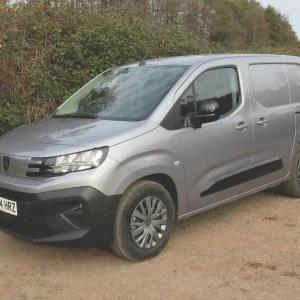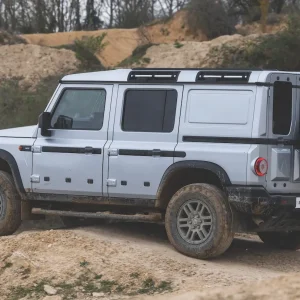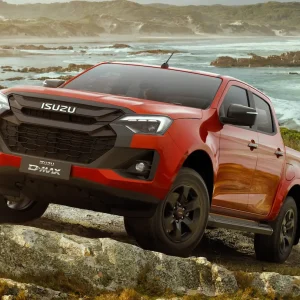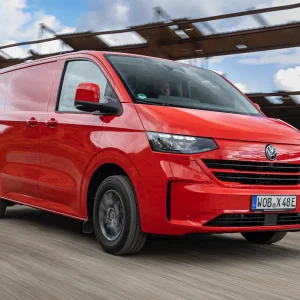Fancy a shiny new British-built Vivaro? Then hang on a minute before you dash down to your local Vauxhall dealership because it might pay you to shop around.
What is basically the same model is available at Citroen outlets badged as the Dispatch. Chat to your nearest Peugeot dealer and you will quickly discover that it is on offer under the Expert banner too.
There is no reason why you shouldn’t play all three dealers off against one another to get the best possible deal on the same vehicle.
All three brands are owned by PSA Group, which acquired Vauxhall in 2017. What is more, under a joint venture agreement Toyota is marketing the Vivaro/Dispatch/Expert as the Proace – so that’s another dealership you can factor into the equation.
The Proace differs from the other three because it is not yet available in battery-electric guise, but will be during the course of next year.
Nor is it assembled at Vauxhall’s Luton plant; not yet at least. The Vivaro is, and it is not alone.
In an exclusive story back in January, What Van? revealed that Dispatch and Expert models had begun rolling down the Bedfordshire production line – the first Citroens to be built in the UK since 1965, and the first Peugeots to be built here since 2006.
One wonders where all this will go next now that PSA has inked a 50/50 merger deal with Fiat Chrysler Automobiles.
The Vivaro, Dispatch, Expert and Proace all have styling differences but are the same under the skin, so we decided to sample what Citroen has to offer.
Originally launched in 2016, the Dispatch has undergone a few changes since we tried an early right-hand drive pre-production version shorn of some of the specifications that would eventually appear on models sold through Citroen dealerships.
Last year saw the engine line-up rejigged. Offered at either 95hp or 115hp, the old 1.6-litre diesel was dropped in favour of a 1.5-litre producing a flat 100hp.
The established 2.0-litre diesels were upgraded in line with the more exacting Euro6d-Temp emission regulations, but still generate 120hp, 150hp or 180hp. The most powerful of the trio used to come with a six-speed automatic gearbox as standard, but this has been upgraded to the EAT8 eight-speeder.
A six-speed manual box is standard on all other models.
The big news is the arrival of the battery-electric e-Dispatch with a 100kW motor and the choice of either a 50kWh or a 75kWh battery. The former offers a range of up to 143 miles between recharges while the latter is good for up to 205 miles, states Citroen.
Looking across the range, the X version remains the entry-level model, but customers can move up a level and select Enterprise specification instead. However, they are not the only choices.
The engine revamp coincided with a reworking of the specification line-up, with the addition of Worker (enhanced traction, higher ground clearance) and Driver (extra safety devices, satnav) trim levels first seen in the Berlingo.
Enterprise+ trim has been quietly expunged from the Dispatch price list.
Two wheelbases and three body lengths – XS, M and XL – are listed, but just one roof height, which at 1.9m is low enough to allow you to access most car parks. The load cubes run from 4.6m3 to 6.1m3 while vehicle gross payloads extend from 960kg up to 1,469kg.
The Dispatch is marketed as a crew van too.
We opted for a Citroen Dispatch BlueHDi 120 S&S M 1400 Enterprise powered by the 120hp diesel. Can it still cut the mustard over four years after the first model appeared?

Load bay
Twin rear doors, which can be swung through 90° – and through 180° if you release the stays – plus a sliding door on each side of the body gives access to the cargo area. The cab and the load bay can be locked and unlocked separately from behind the steering wheel, and all the doors lock automatically when the light commercial is in motion.
Six tie-down points are provided and a full-height steel bulkhead should protect the occupants of the cab if unsecured items slide forwards.
Under the Moduwork banner, a flap in the bottom of the bulkhead directly behind the outboard passenger seat allows extra-long items to be slid forwards into the three-seater cab.
The outboard seat can be folded upwards and backwards against the bulkhead to create extra carrying space. Doing so reveals an additional tie-down ring in the passenger seat footwell.
Hardboard panels on the doors and above the wheel boxes provide some defence against scratches and scrapes. The load area will require timbering out properly, however, in order to protect it against more significant damage, and that will include a tailored timber cover for the unprotected load bed.
The Enterprise and Driver models can both be ordered with an optional Easy Entry Pack (not fitted to our demonstrator) that includes keyless entry and start, twin electric sliding side doors with hands-free opening and an electronically lockable fuel filler cap – yours for a hefty £1,125 if you feel you really want or need it.

Interior and equipment
Times change, and all the latest Dispatch vans are equipped with Citroen Connect Box as standard in line with European regulations.
If the van is involved in a collision, the box calls the emergency services and pinpoints its location. Press the SOS button and you can activate it manually, and you can contact the Citroen support switchboard by pressing and holding the Double Chevron button.
If you are travelling as a passenger then you should try to avoid the middle seat.
The way in which the moulding, which accommodates the gear lever, bows out from the dashboard will restrict your legroom. Your right kneecap is likely to be jammed right up against it – not a situation you want to be in on a long journey.
The middle seat offers a useful benefit, however: the centre section of its back folds downwards and can be used as a desk, complete with an elasticated band to hold paperwork in place.
Pull up the cushion and you will find a handy compartment you can use to conceal your smartphone.
Air conditioning is included in the Enterprise deal, as are electric windows and power-operated and electrically adjustable exterior mirrors. The latter do not have a wide-angle section, alas.
Other features include cruise control with a programmable speed limiter, an alarm, driver and passenger airbags, a 12V power point – you’ll find one in the load area too – plus a USB socket and an audio jack. A 7in colour touchscreen is fitted along with a DAB radio and the cab is Bluetooth-enabled. Smartphone integration is another feature, with Android Auto and Apple CarPlay.
The driver’s seat and the steering wheel are height-adjustable, and the latter can be adjusted for reach. The former features an inboard armrest and lumbar adjustment.
Each door features three storage bins while the passenger side of the dashboard offers a roomy parcel shelf with a narrow shelf just above it.
You will find another shelf in the middle of the fascia just above the gearstick. A further shelf is let into the top of the dashboard, which also boasts a cupholder at either extremity.
Onboard safety systems include ABS, electronic stability control with hill assist, and emergency brake assist.
A wide variety of other safety aids are listed as options, including lane departure warning, speed limit recognition and intelligent speed adaption. None of them were available when the Citroen Dispatch first appeared, which shows the extent to which onboard safety has progressed.
Reversing sensors are installed, and a schematic display on the touchscreen shows you how close you are getting to any obstruction. A coffee cup symbol appears after two hours continuous driving telling you that you should take a break.
The suspension employs MacPherson struts and an anti-roll bar at the front along with a trailing arm set up at the rear. Electric power steering delivers a 12.4m turning circle between kerbs, increasing to 12.9m between walls.
Disc brakes are fitted all round and our van’s 16in steel wheels had Michelin Agilis 51 215/65 R16C tyres.

Powertrain
The four-cylinder in-line transverse-mounted common-rail turbodiesel delivers maximum power at 3,750rpm. Maximum torque of 340Nm kicks in at 1,750rpm.
AdBlue is required to ensure the van meets the Euro6 exhaust emission regulations. The reservoir filler point is concealed by the passenger door.
Driving
One of the Dispatch’s big plus points is its sharp handling. Push it hard into a bend and it keeps hanging on in there, showing little inclination to break away. The responsive steering helps. It tells you everything you need to know about the interaction between the front wheels and the road surface, and it gives you fair warning if you get over-ambitious.
On-highway performance in terms of acceleration from rest and up through the gears is acceptable, but not outstanding, and a crisper gear change would be welcome. Engaging reverse could be a tussle on our demonstrator, and one we could have done without.
The ride could be a mite choppy even on smooth surfaces, but in-cab noise levels were well under control.

Operating
Citroen’s quality control needs tightening up. Although our test van had only clocked up a modest mileage the parcel shelf was working loose, as was the side rubbing strip on the driver’s door.
Service intervals are set at two years/25,000 miles and the Dispatch is covered by a three-year/100,000-mile warranty, with no mileage limit in the first two years. If you are proposing to hang on to your light commercial for a while then bear in mind that Toyota’s Proace carries a five-year/100,000-mile warranty.
Fuel economy? The maximum WLTP (Worldwide Harmonised Light Vehicle Test Procedure) combined figure cited is 40.5mpg, but we did rather better, at closer to 45mpg.
S&S – Stop & Start – is a standard feature, and not something we experienced on the first version of the current Dispatch we drove. It kills the engine at the traffic lights or in queues, while making it easy to restart.
Citroen Dispatch BlueHDi 120 S&S M 1400 Enterprise
Price (ex VAT) £26,030
Price range (ex VAT) £23,645-£42,380
Gross payload 1,458kg
Load volume 5.3m3
Load length 2,512mm
Load width (min/max) 1,258/1,628mm
Load bay height 1,397mm
Loading height 544mm
Rear door aperture 1,282 x 1,220mm
Side door aperture 935 x 1,241mm
Gross vehicle weight 3,100kg
Braked trailer towing weight 2,500kg
Residual value 19.8 % (after 4yrs/80,000mls source: KwikCarcost)
Cost per mile 50.7p
Engine size/power 1,997cc, 120hp @ 3,750rpm
Torque 340Nm @ 1,750rpm
Gearbox 6-spd
Fuel economy (WLTP) 40.5mpg
Fuel tank 70 litres
CO2 (WLTP) 190g/km
Warranty 3yrs/100,000mls
Service intervals 2yrs/25,000mls
Insurance group 38E
Price as tested £26,490
Options
Metallic paint £460
Rivals
Ford Transit Custom
Price (ex VAT) £23,090-£43,925
Load volume 6.0-8.3m3
Gross payload 685-1,459kg
Engines 105hp, 130hp, 170hp, 185hp 2.0 diesel, 92.9kW PHEV
Verdict: This is one of Ford’s most significant UK van market success stories. Its handling, ride and overall performance are all top-notch, and the PHEV plug-in hybrid and mHEV mild hybrid are both likely to appeal to customers who want to cut emissions, but still suffer from range anxiety. That helped Ford drive off with the What Van? 2020 Green Manufacturer of the Year award.
Renault Trafic
Price (ex VAT) £23,450-£34,400
Load volume 5.2-8.6m3
Gross payload 1,036-1,255kg
Engines 120hp, l45hp, 170hp diesel
Verdict: The Trafic was extensively revised in 2019, receiving new engines plus the Efficient Dual Clutch gearbox – an exemplary transmission that is undoubtedlty worth sampling. The Trafic is short of some of the more intelligent safety devices found on certain of its key competitors, however – a lack that Renault needs to address. The Trafic is also marketed by Nissan as the NV300 and by Fiat Professional as the Talento.
Volkswagen Transporter
Price (ex VAT) £22,115-£49,290
Load volume 5.8-9.3m3
Gross payload 713-1,309kg
Engines 90hp, 110hp, 150hp, 199hp 2.0 diesel, 83kW battery-electric
Verdict: With a very high level of build quality plus a commendable emphasis on safety, the Transporter ticks almost all the boxes. It has just ticked one more with the advent of a battery-electric model produced in conjunction with ABT. Strong engines and a slick gear-change complete the picture, but the van’s styling is less than exciting.
The Final Verdict
Design 7/10 – Attractive-looking with some practical features.
Cabin 6/10 – Three seats in a cab when there is really only room for two seems ill-advised.
Ride 7/10 – Tad choppy even on smooth highways, but improves with weight on board.
Refinement 6/10 – In-cab noise under control, but some loose trim cheapened the experience.
Load area 7/10 – Ability to push extra-long items through a flap in the bulkhead is a plus point.
Handling/performance 8/10 – The former is exemplary. Performance turned out to be adequate.
Engine/transmission 6/10 – No issues with the first. The latter not always as smooth as it might’ve been.
Standard equipment 8/10 – Lots of comfort-inducing goodies, but more safety stuff would’ve been good.
Operating costs 6/10 – Decent warranty, but quality control needs tightening up.
What Van? subjective rating 7/10 – Lots to commend in a competent package, but lags behind the Transit Custom.
Overall Rating = 68/100





